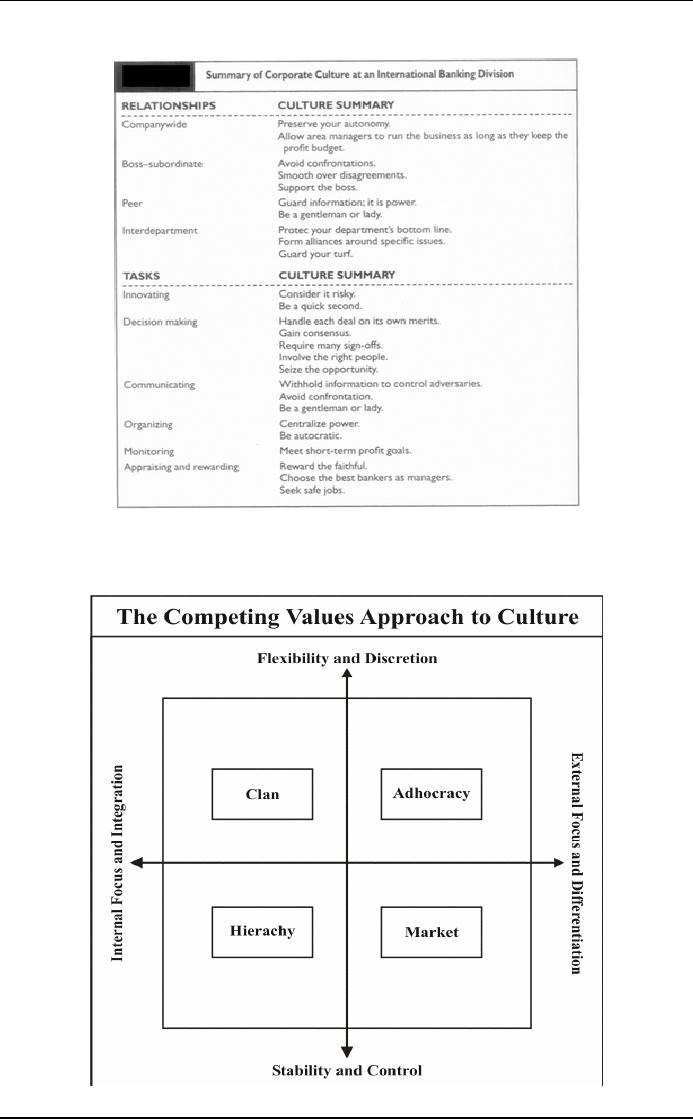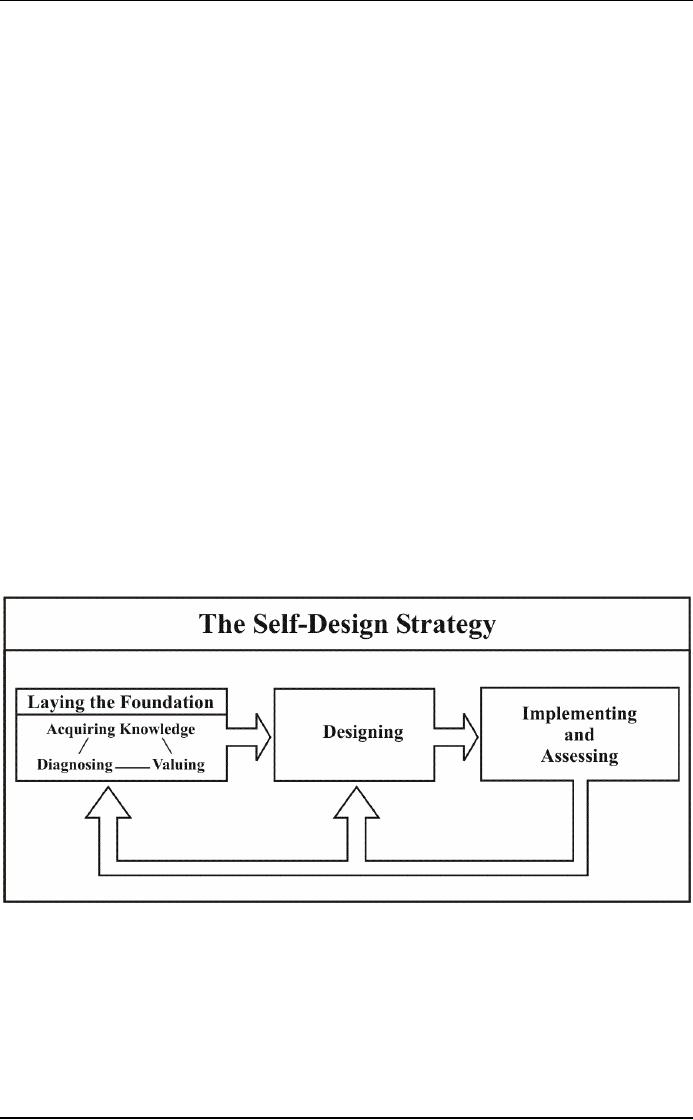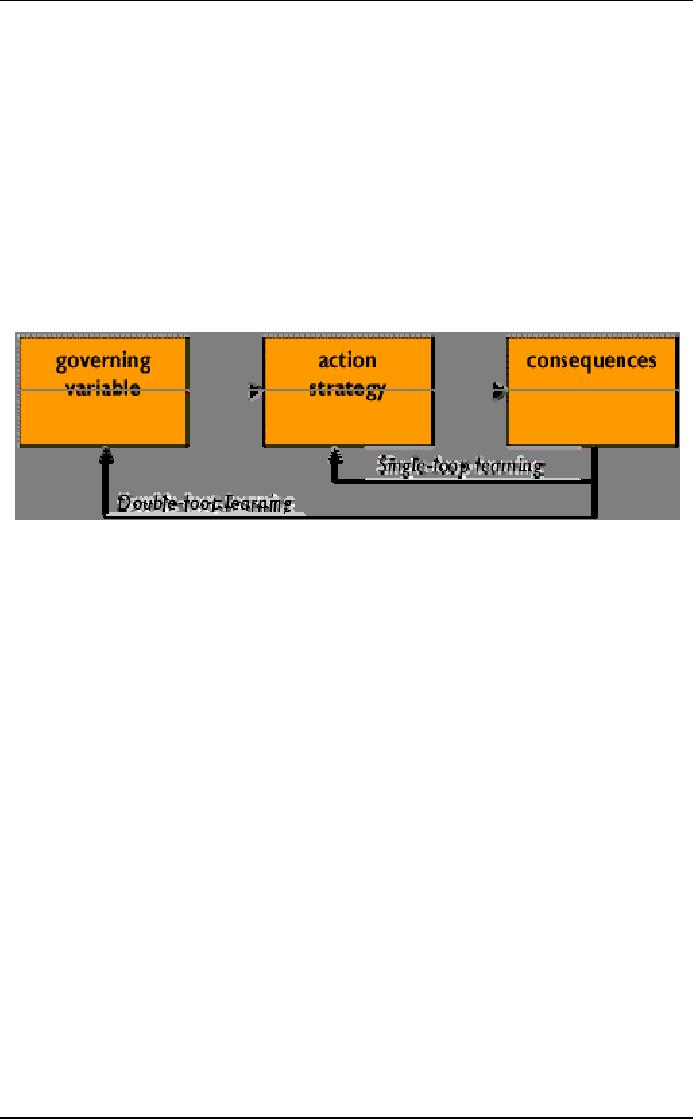 |

Organization
Development MGMT
628
VU
Lesson
# 44
The
Behavioral Approach
This
method of diagnosis emphasizes the
surface level of organization culture--the pattern of
behaviors
that
produce business results. It is
among the more practical
approaches to culture diagnosis because
it
assesses
key work behaviors that
can be observed. The behavioral
approach provides specific
descriptions
about
how tasks are performed
and how relationships are
managed in an organization. For example,
Table
25
summarizes the organization culture of an
international banking division as
perceived by its
managers.
The
data were obtained from a
series of individual and
group interviews asking managers to
describe "the
way
the game is played," as if they were
coaching a new organization member.
Managers were asked to
give
their
impressions in regard to four
key relationships--companywide, boss-subordinate,
peer, and
interdepartmental--and
in terms of six managerial
tasks--innovating, decision making,
communicating,
organizing,
monitoring, and appraising/rewarding.
These perceptions revealed a number of
implicit norms
for
how tasks are performed
and relationships managed at the
division.
Cultural
diagnosis derived from a behavioral
approach can also be used to
assess the cultural risk of trying
to
implement organizational changes needed to
support a new strategy. Significant
cultural risks result when
changes
that are highly important to
implementing a new strategy are
incompatible with the existing
patterns
of behavior. Knowledge of such
risks can help managers
determine whether implementation
plans
should
be changed to manage around the existing culture,
whether the culture should be changed, or
whether
the strategy itself should be modified or
abandoned.
The
Competing Values
Approach
This
perspective assesses an organization's
culture in terms of how it resolves a
set of value dilemmas.
The
approach
suggests that an organization's culture
can be understood in terms of two
important "value pairs";
each
pair consists of contradictory
values placed at opposite ends of a
continuum, as shown in Figure
59.
The
two value pairs are
(1) internal focus and
integration versus external focus
and differentiation and
(2)
flexibility
and discretion versus stability
and control. Organizations continually
struggle to satisfy the
conflicting
demands placed on them by these competing
values. For example, when
faced with the
competing
values of internal versus external
focus, organizations must
choose between attending to the
integration
problems of internal operations or the
competitive issues in the external
environment. Too
much
emphasis on the environment can
result in neglect of internal
efficiencies. Conversely, too
much
attention
to the internal aspects of organizations
can result in missing
important changes in the
competitive
environment.
The
competing values approach commonly
collects diagnostic data about the
competing values with a
survey
designed specifically for
that purpose. It provides measures of
where an organization's existing
values
fall along each of the dimensions.
When taken together, these
data identify an organization's
culture
as
falling into one of the four
quadrants shown in Figure 59:
clan culture, adhocracy culture,
hierarchical
culture,
and market culture. For
example, if an organization's values
are focused on internal
integration
issues
and emphasize innovation and
flexibility, it manifests a clan culture.
On the other hand, a
market
culture
characterizes values that
are externally focused and
emphasize stability and
control.

Organization
Development MGMT
628
VU
Table
25
Figure
59

Organization
Development MGMT
628
VU
The
Deep Assumptions
Approach
This
final diagnostic approach
emphasizes the deepest levels of
organization culture--the
generally
unexamined,
but tacit and shared
assumptions that guide
member behavior and that
often have a powerful
impact
on organization effectiveness. Diagnosing culture from
this perspective typically begins
with the
most
tangible level of awareness and then
works down to the deep
assumptions.
Diagnosing
organization culture at the deep assumptions level
poses at least three
difficult problems
for
collecting
pertinent information. First, culture
reflects shared assumptions
about what is important,
how
things
are done, and how people
should behave in organizations. People
generally take cultural
assumptions
for
granted and rarely speak of
them directly. Rather, the
company's culture is implied in
concrete
behavioral
examples, such as daily routines,
stories, rituals, and language. This
means that considerable
time
and
effort must be spent observing,
sifting through, and asking
people about these cultural outcroppings
to
understand
their deeper significance
for organization members. Second,
some values and beliefs
that
people
espouse have little to do
with the ones they really hold
and follow. People are
reluctant to admit this
discrepancy,
yet somehow the real
assumptions underlying idealized
portrayals of culture must be
discovered.
Third, large, diverse
organizations are likely to
have several subcultures,
including
countercultures
going against the grain of the wider organization culture.
Assumptions may not be
shared
widely
and may differ across
groups in the organization. This means
that focusing on limited
parts of the
organization
or on a few select individuals may
provide a distorted view of the
organization's culture and
subcultures.
All relevant groups in the organization
must be discovered and their
cultural assumptions
sampled.
Only then can practitioners
judge the extent to which assumptions
are shared widely.
OD
practitioners emphasizing the deep
assumptions approach have developed a
number of useful
techniques
for assessing organization culture. One method
involves an iterative interviewing
process
involving
both outsiders and insiders.
Outsiders help members uncover cultural
elements through
joint
exploration.
The outsider enters the organization and
experiences surprises and
puzzles that are
different
from
what was expected. The outsider
shares these observations
with insiders, and the two
parties jointly
explore
their meaning. This process
involves several iterations of experiencing
surprises, checking
for
meaning,
and formulating hypotheses
about the culture. It results in a formal
written description of the
assumptions
underlying an organizational culture.
A
second method for
identifying the organization's basic
assumptions brings together a group of
people for
a
culture workshop--for example, a senior
management team or a cross
section of managers, old and
new
members,
labor leaders, and staff.
The group first brainstorms
a large number of artifacts, such as
behav-
iors,
symbols, language, and
physical space arrangements.
From this list, the values and
norms that would
produce
such artifacts are deduced.
In addition, the values espoused in
formal planning documents
are
listed.
Finally, the group attempts to
identify the assumptions that
would explain the constellation of
values,
norms,
and artifacts. Because they
generally are taken for
granted, they are difficult to
articulate. A great
deal
of process consultation skill is required to
help organization members see the
underlying assumptions.
Application
Stages
There
is considerable debate over whether
changing something as deep-seated as
organization culture is
possible.
Those advocating culture change
generally focus on the more superficial
elements of culture, such
as
norms and artifacts. These
elements are more changeable
than the deeper elements of values
and basic
assumptions.
They offer OD practitioners a more
manageable set of action levers
for changing or-
ganizational
behaviors. Some would argue,
however, that unless the deeper
values and assumptions
are
changed,
organizations have not really
changed the culture.
Those
arguing that implementing culture change
is extremely difficult, if not
impossible, typically focus
on
the
deeper elements of culture (values
and basic assumptions).
Because these deeper
elements represent
assumptions
about organizational life, members do
not question them and have a
difficult time envisioning
anything
else. Moreover, members may
not want to change their cultural
assumptions. The culture provides
a
strong defense against external
uncertainties and threats. It
represents past solutions to difficult
problems.
Members
also may have vested
interests in maintaining the culture. They
may have developed
personal
stakes,
pride, and power in the culture and may
strongly resist attempts to change
it. Finally, cultures
that
provide
firms with a competitive advantage
may be difficult to imitate, thus making
it hard for less
successful
firms to change their cultures to
approximate the more successful
ones.

Organization
Development MGMT
628
VU
Given
the problems with cultural change,
most practitioners in this area suggest
that changes in corporate
culture
should be considered only after other,
less difficult and less
costly solutions have been applied
or
ruled
out. Attempts to overcome cultural
risks when strategic changes
are incompatible with culture
might
include
ways to manage around the existing culture. Consider,
for example, a single-product
organization
with
a functional focus and a
history of centralized control
that is considering an ambitious
product-
diversification
strategy. The firm might
manage around its existing culture by
using business teams
to
coordinate
functional specialists around each
new product. Another alternative to
changing culture is to
modify
strategy to bring it more in
line with culture. The single-product
organization just mentioned might
decide
to undertake a less ambitious strategy of
product diversification.
Despite
problems in changing corporate culture,
large-scale cultural change may be
necessary in certain
situations:
if the firm's culture does not fit a
changing environment; if the industry is
extremely competitive
and
changes rapidly; if the company is
mediocre or worse; if the firm is
about to become a very
large
company;
or if the company is smaller and
growing rapidly. Organizations facing
these conditions need
to
change
their cultures to adapt to the
situation or to operate at higher levels
of effectiveness. They may
have
to
supplement attempts at cultural change
with other approaches, such
as managing around the existing
culture
and modifying
strategy.
Although
knowledge about changing corporate culture is in a
formative stage, the following
practical advice
can
serve as guidelines for cultural
change:
1.
Formulate a clear strategic
vision. Effective
cultural change should start from a
clear vision of the
firm's
new strategy and of the
shared values and behaviors
needed to make it work. This
vision provides
the
purpose and direction for
cultural change. It serves as a yardstick
for defining the firm's existing
culture
and
for deciding whether proposed changes
are consistent with core
values of the organization. A
useful
approach
to providing clear strategic
vision is development of a statement of corporate
purpose, listing in
straightforward
terms the firm's core values.
For example, Johnson &
Johnson calls its guiding
principles
"Our
Credo." It describes several
basic values that guide the
firm, including, "We believe
our first
responsibility
is to the doctors, nurses and
patients, to mothers and all
others who use our products
and
services";
"Our suppliers and
distributors must have an
opportunity to make a fair
profit"; "We must
respect
[employees'] dignity and
recognize their merit"; and
"We must maintain in good
order the property
we
are privileged to use,
protecting the environment and natural
resources."
2.
Display top-management commitment.
Cultural
change must be managed from
the top of the
organization.
Senior managers and
administrators have to be strongly committed to the
new values and
need
to create constant pressures
for change. They must
have the staying power to see the
changes
through.
For example, Jack Welch,
CEO at General Electric, has
enthusiastically pushed a policy of
cost
cutting,
improved productivity, customer
focus, and bureaucracy busting
for more than ten years to
every
plant,
division, group, and sector in
his organization. His efforts
were rewarded with a Fortune
cover story
lauding
his organization for creating
more than $52 billion in
shareholder value during his
tenure.
3.
Model culture change at the
highest levels. Senior
executives must communicate the
new culture
through
their own actions. Their
behaviors need to symbolize the kinds of
values and behaviors
being
sought.
In the few publicized cases of successful culture
change, corporate leaders have
shown an almost
missionary
zeal for the new values;
their actions have
symbolized the values forcefully.
For example, Jim
Treybig,
CEO of Tandem, the computer manufacturer,
decided not to fire an
employee whose
performance
had slipped until he could investigate
the reason for the employee's
poor performance. It
turned
out that the employee was
having family problems, and therefore
Treybig gave him another
chance.
To
the people at Tandem, the story
symbolized the importance of consideration in leading
people.
4.
Modify the organization to support
organizational change. Cultural
change generally
requires
supporting
modifications in organizational structure,
human resources systems,
information and
control
systems,
and management styles. These
organizational features can help to
orient people's behaviors to
the
new
culture. They can make people aware of
the behaviors required to get things done in the
new culture
and
can encourage performance of
those behaviors. For
example, Phil Condit and
Harry Stonecipher of
Boeing
realized that more than
culture change in the commercial aircraft
division was necessary to
turn
around
the organization's poor performance in
1997 and 1998. To alter the
"warm and fuzzy" culture
of
the
division radically, they initiated
workforce reductions, fired
key executives, made changes
in the
production
standards, and initiated continuous
improvement processes in production.
These changes rein-
forced
and symbolized the importance of financial
performance, accountability, and global
leadership in the
industry.
5.
Select and socialize newcomers and
terminate deviants. One of the
most effective methods
for
changing
corporate culture is to change organizational
membership. People can be
selected and terminated
in
terms of their fit with the
new culture. This is especially important
in key leadership positions,
where

Organization
Development MGMT
628
VU
people's
actions can significantly promote or
hinder new values and
behaviors. For example,
Gould, in
trying
to change from an auto parts
and battery company to a leader in
electronics, replaced about
two-
thirds
of its senior executives
with people more in tune with the
new strategy and culture.
Jan Carlzon of
Scandinavian
Airlines (SAS) replaced
thirteen out of fifteen top
executives in his turnaround of the
airline.
Another
approach is to socialize newly hired
people into the new culture. People
are most open to
organizational
influences during the entry
stage, when they can be
effectively indoctrinated into the
culture.
For
example, companies with strong
cultures like Samsung,
Procter & Gamble, and 3M attach
great
importance
to socializing new members
into the company's
values.
6.
Develop ethical and legal sensitivity.
Cultural
change can raise significant
tensions between
organization
and individual interests, resulting in
ethical and legal problems
for practitioners. This is
particularly
pertinent when organizations
are trying to implement cultural values
promoting employee
integrity,
control, equitable treatment, and job
security--values often included in cultural change
efforts.
Statements
about such values provide
employees with certain
expectations about their rights and
about
how
they will be treated in the organization. If the
organization does not follow
through with
behaviors
and
procedures supporting and
protecting these implied
rights, it may breach
ethical principles and, in
some
cases, legal employment contracts.
Recommendations for reducing the
chances of such ethical
and
legal
problems include setting realistic
values for culture change
and not promising what the
organization
cannot
deliver; encouraging input from
throughout the organization in setting cultural
values; providing
mechanisms
for member dissent and
diversity, such as internal review
procedures; and educating
managers
about
the legal and ethical
pitfalls inherent in cultural change
and helping them develop guidelines
for
resolving
such issues.
Self-Designing
Organizations
A
growing number of researchers and
practitioners have called for
self-designing organizations that
have
the
built-in capacity to transform themselves
to achieve high performance in
today's competitive and
changing
environment. Mohrman and
Cummings have developed a self-design
change strategy that
involves
an ongoing series of designing
and implementing activities carried
out by managers and
employees
at
all levels of the firm. The
approach helps members
translate corporate values and
general prescriptions
for
change into specific
structures, processes, and
behaviors suited to their
situations. It enables them to
tailor
changes to fit the organization and
helps them continually to adjust the
organization to changing
conditions.
The
Demands of Transformational
Change
Mohrman
and Cummings developed the self-design
strategy in response to a number of
demands facing
organizations
engaged in transformational change. These
demands strongly suggest the need
for self-design,
in
contrast to more traditional
approaches to organization change that
emphasize ready-made
programs
and
quick fixes. Although
organizations prefer the control and
certainty inherent in programmed
change,
the
five requirements for organizational
transformation reviewed below
argue against this
strategy:
1.
Transformational change generally
involves altering most features of the organization
and achieving a
fit
among them and with the firm's
strategy. This suggests the need
for a systemic change
process that
accounts
for these multiple features
and relationships.
2.
Transformational change generally
occurs in situations experiencing
heavy change and uncertainty.
This
means
that changing is never
totally finished, as new structures
and processes will
continually have to be
modified
to fit changing conditions. Thus, the
change process needs to be
dynamic and iterative,
with
organizations
continually changing
themselves.
3.
Current knowledge about transforming
organizations provides only general
prescriptions for
change.
Organizations
need to learn how to
translate that information
into specific structures,
processes, and
behaviors
appropriate to their situations. This
generally requires considerable on-site
innovation and
learning
as members learn by doing--trying
out new structures and
behaviors, assessing their
effectiveness,
and
modifying them if necessary.
Transformational change needs to
facilitate this organizational learning.
4.
Transformational
change invariably affects
many organization stakeholders, including
owners,
managers,
employees, and customers.
These different stakeholders
are likely to have different
goals and
interests
related to the change process.
Unless the differences are
revealed and reconciled,
enthusiastic
support
for change may be difficult
to achieve. Consequently, the change
process must attend to
the
interests
of multiple stakeholders.
5.
Transformational change needs to
occur at multiple levels of the
organization if new strategies are
to
result
in changed behaviors throughout the
firm. Top executives must
formulate a corporate strategy
and
clarify
a vision of what the organization needs to
look like to support it.
Middle and lower levels of
the
organization
need to put those broad
parameters into operation by
creating structures, procedures,
and
behaviors
to implement the strategy.

Organization
Development MGMT
628
VU
Application
Stages
The
self-design strategy accounts
for these demands of organization
transformation. It focuses on all
features
of the organization (for example,
structure, human resources
practices, and technology)
and
designs
them to support the business strategy
mutually. It is a dynamic and an
iterative process aimed
at
providing
organizations with the built-in
capacity to change and
redesign themselves continually as
the
circumstances
demand. The approach
promotes organizational learning among
multiple stakeholders- at
all
levels
of the firm, providing them with the
knowledge and skills needed to transform
the organization and
continually
to improve it.
Figure
60 outlines the self-design approach.
Although the process is described in
three stages, in
practice
the
stages merge and interact
iteratively over time. Each
stage is described below:
Figure
60. The Self-Design
Strategy
1.
Laying the foundation. This
initial stage provides organization
members with the basic knowledge
and
information
needed to get started with
organization transformation. It involves three kinds of
activities.
The
first is acquiring knowledge about how
organizations function, about organizing principles
for achiev-
ing
high performance, and about the
self-design process. This information is
generally gained
through
reading
relevant material, attending in-house
workshops, and visiting
other organizations that
successfully
have
transformed themselves. This learning typically
starts with senior
executives or with those
managing
the
transformation process and
cascades to lower organizational levels
if a decision is made to proceed
with
self-design.
The second activity in laying the
foundation involves valuing--determining
the corporate

Organization
Development MGMT
628
VU
values
that will guide the
transformation process. These
values represent those
performance outcomes
and
organizational
conditions that will be
needed to implement the corporate strategy. They
are typically written
in
a values statement that is
discussed and negotiated among
multiple stakeholders at all
levels of the
organization.
The third activity is
diagnosing the current organization to determine what
needs to be
changed
to enact the corporate strategy and
values. Organization members generally
assess the different
features
of the organization, including its
performance. They look for incongruities
between its
functioning
and
its valued performances and
conditions. In the case of an entirely
new organization, members
diagnose
constraints
and contingencies in the situation
that need to be taken into
account in designing the
organization.
2.
Designing. In this
second stage of self-design, organization
designs and innovations are
generated to
support
corporate strategy and values.
Only the broad parameters of a new
organization are specified; the
details
are left to be tailored to the
levels and groupings within the
organization. Referred to as
minimum
specification
design, this process recognizes
that designs need to be
refined and modified as they
are
implemented
throughout the firm.
3.
Implementing and assessing. This
last stage involves implementing the
designed organization
changes.
It includes an ongoing cycle of action
research: changing structures
and behaviors,
assessing
progress,
and making necessary modifications.
Information about how well
implementation is progressing
and
how well the new organizational
design is working is collected
and used to clarify design
and
implementation
issues and to make necessary
adjustments. This learning process
continues not only
during
implementation
but indefinitely as members periodically
assess and improve the
design and alter it to
fit
changing
conditions. The feedback loops shown in
Figure 20.3 suggest that the implementing
and assessing
activities
may lead back to affect
subsequent designing, diagnosing,
valuing, and acquiring knowledge
activities.
This iterative sequence of activities
provides organizations with the capacity
to transform and
improve
themselves continually.
The
self-design strategy is applicable to
existing organizations needing to transform
themselves, as well as
to
new organizations just starting
out. It is also applicable to
changing the total organization or
subunits.
The
way self-design is managed
and unfolds can also
differ. In some cases, it
follows the existing
organization
structure, starting with the senior
executive team and cascading
downward across orga-
nizational
levels. In other cases, the
process is managed by special
design teams that are
sanctioned to set
broad
parameters for valuing and
designing for the rest of the
organization. The outputs of these
teams
then
are implemented across departments
and work units, with
considerable local refinement
and
modification.
The
Learning Organization
Organization
Learning interventions address how
organizations can be designed to
promote effective
learning
processes and how those
learning processes themselves can be
improved.
The
learning organization builds on a number of ideas. It
has its roots in OD and uses
the ideas and
philosophies
of action research, systems approach,
organizational culture, continuous problem-solving,
self-
managed
work teams, collaboration,
participative leadership, and
interpersonal relations. The
learning
organization
is a system-wide change program that
emphasizes the reduction of organizational
layers and
the
involvement of every body in the
organization in continuous self-directing learning that
will lead toward
positive
change and growth in the
individual, team, and
organization.
According
to Peter Senge, "Leaders in learning
organizations are responsible
for building
organizations
where
individuals continually expand
their capabilities to shape
their future. Leaders are
responsible for
fostering
learning and are themselves
learners." Learning in organizations
means the continuous testing of
experience
and the transformation of that
experience into knowledge accessible to
the whole organization
and
relevant to its core
purpose.
Learning
organizations emphasize creating
"knowledge for action" and
not "knowledge for its
own sake."
They
focus on acquiring knowledge, sharing it
across the organization, and using it to
achieve
organizational
goals. Participants must liberate
themselves from such mental
traps as blaming the
competition,
the economy, or other factors beyond
their control. Learning organization
realize that they are
part
of a larger system over
which they have little or no
control. Instead of complaining, they seek
out
opportunities
and "ride the wave."
Core
Values
A
strong set of core values is
normally present in learning
organizations:
·
Value
different kinds of knowledge and learning
styles.

Organization
Development MGMT
628
VU
·
Encourage
communication between people with
different perspectives and
ideas.
·
Develop
creative thinking.
·
Remain
nonjudgmental of others and their
ideas.
·
Break
down traditional barriers in the
organization.
·
Develop
leadership throughout organization. Everyone is a
leader.
·
Reduce
distinctions between organization members.
(Management vs. non-management,
line vs.
staff,
doers vs. thinkers, professional
vs. nonprofessional, & so on.)
·
Believe
that every member of the organization
has untapped human
potential.
Becoming
a learning organization increases the size of the
organization's "brain." The
employees
throughout
the organization participate in all thinking
activities. The boundaries
between the parts of the
organization
are broken down.
Characteristics
of a Learning Organization
Four
characteristics define a learning organization:
1.
Constant
Readiness: The
organization exists in constant readiness
for change. By staying in
tune
with
its environment, the organization is
ready to take advantage of
new opportunities.
2.
Continuous
Planning: Instead of a
few top executives
formulating fixed plans, the
learning
organization
creates flexible plans that
are fully known and
accepted by the entire organization.
The
plans are constantly reexamined by
those involved with their
implementation not just
top
management.
The old adage that
"the top thinks and the
bottom acts" has given way
to the need
for
"integrated thinking and
acting at all levels."
3.
Improvised
Implementation. The
learning organization improvises. Instead of
rigidly
implementing
plans, it encourages experimentation.
Coordination and collaboration of
everyone
involved
is required in the implementation. Successes are
identified and institutionalized
within the
organization.
4.
Action
Learning.
Change is reevaluated continually
and not just at annual
planning sessions.
Instead
the learning organization is constantly taking action, reflecting,
and making adjustments.
In
short, learning organizations do not wait
for problems to arise. They
are constantly undergoing a
reexamination
that questions and tests
assumptions.
Organization
Learning Processes
These
processes consist of four interrelated
activities:
1.
Discovery: Learning
starts with discovery when
errors or gaps between
desired and actual
conditions are
detected.
For example, sales managers
may discover that sales
are falling below projected
levels and set
out
to
solve the problem.
2.
Invention is
aimed at devising solutions to close the
gap between desired and
current conditions, and
includes
diagnosing the causes of the gap
and creating appropriate solutions to
reduce it.
The
sales
managers
may learn that poor
advertising is contributing to the sales
problem and may devise a
new sales
campaign
to improve sales.
3.
Production processes
involve implementing solutions. For
instance, the new advertising program
would
be
implemented.
4.
Generalization includes
drawing conclusions about the effects of the
solutions, if successful, and
extending
that knowledge, to other relevant
situations. The managers
might use variations of it with
other
product
lines. Thus, these four
learning processes enable members to
generate the knowledge necessary
to
change
and improve the organization.
Levels
of Learning
Inferring
from the learning processes, we can
identify two levels of
learning.
The
lowest level is called single-loop learning or
adaptive learning and is focused on
learning how to
improve
the status quo. This is the most
prevalent form of learning in organizations
and enables members
to
reduce errors or gaps
between desired and existing conditions.
It can produce incremental change
in
how
organizations function. The
sales managers described
above engaged in single-loop learning when
they
looked
for ways to reduce the difference
between current and desired
levels of sales.

Organization
Development MGMT
628
VU
Single-loop
learning is like a thermostat that
learns when it is too hot or
too cold and turns the heat on
or
off.
The thermostat can perform
this task because it can
receive information (the temperature of
the room)
and
take corrective action.
Double-loop
learning or generative learning is aimed at
changing the status quo. It operates at a
more
abstract
level than does single-loop learning
because members learn how to
change the existing
assumptions
and conditions within which
single-loop learning operates. This level of learning
can lead to
transformational
change, where the status quo
itself is radically altered.
For example, the sales
managers
may
learn that sales projections
are based on faulty
assumptions and models about
future market
conditions.
This knowledge may result in an
entirely new conception of future
markets with corresponding
changes
in sales projections and product
development plans. It may lead the
managers to drop some
products
that had previously appeared promising,
develop new ones that were
not considered before,
and
alter
advertising and promotional campaigns to
fit the new conditions.
Figure
61
In
Single-loop learning the emphasis is on "techniques
and making techniques more
efficient".
Double-loop
learning is more creative and reflexive.
Reflection here is more fundamental: the
basic
assumptions
behind ideas or policies are
confronted. Hypotheses are
publicly tested.
Table of Contents:
- The Challenge for Organizations:The Growth and Relevance of OD
- OD: A Unique Change Strategy:OD consultants utilize a behavioral science base
- What an “ideal” effective, healthy organization would look like?:
- The Evolution of OD:Laboratory Training, Likert Scale, Scoring and analysis,
- The Evolution of OD:Participative Management, Quality of Work Life, Strategic Change
- The Organization Culture:Adjustment to Cultural Norms, Psychological Contracts
- The Nature of Planned Change:Lewin’s Change Model, Case Example: British Airways
- Action Research Model:Termination of the OD Effort, Phases not Steps
- General Model of Planned Change:Entering and Contracting, Magnitude of Change
- The Organization Development Practitioner:External and Internal Practitioners
- Creating a Climate for Change:The Stabilizer Style, The Analyzer Style
- OD Practitioner Skills and Activities:Consultant’s Abilities, Marginality
- Professional Values:Professional Ethics, Ethical Dilemmas, Technical Ineptness
- Entering and Contracting:Clarifying the Organizational Issue, Selecting an OD Practitioner
- Diagnosing Organizations:The Process, The Performance Gap, The Interview Data
- Organization as Open Systems:Equifinality, Diagnosing Organizational Systems
- Diagnosing Organizations:Outputs, Alignment, Analysis
- Diagnosing Groups and Jobs:Design Components, Outputs
- Diagnosing Groups and Jobs:Design Components, Fits
- Collecting and Analyzing Diagnostic information:Methods for Collecting Data, Observations
- Collecting and Analyzing Diagnostic information:Sampling, The Analysis of Data
- Designing Interventions:Readiness for Change, Techno-structural Interventions
- Leading and Managing Change:Motivating Change, The Life Cycle of Resistance to Change
- Leading and managing change:Describing the Core Ideology, Commitment Planning
- Evaluating and Institutionalizing Organization Development Interventions:Measurement
- Evaluating and Institutionalizing Organization Development Interventions:Research Design
- Evaluating and Institutionalizing Organization Development Interventions
- Interpersonal and Group Process Approaches:Group Process
- Interpersonal and Group Process Approaches:Leadership and Authority, Group Interventions
- Interpersonal and Group Process Approaches:Third-Party Interventions
- Interpersonal and Group Process Approaches:Team Building, Team Building Process
- Interpersonal and Group Process Approaches:Team Management Styles
- Organization Process Approaches:Application Stages, Microcosm Groups
- Restructuring Organizations:Structural Design, Process-Based Structures
- Restructuring Organizations:Downsizing, Application Stages, Reengineering
- Employee Involvement:Parallel Structures, Multiple-level committees
- Employee Involvement:Quality Circles, Total Quality Management
- Work Design:The Engineering Approach, Individual Differences, Vertical Loading
- Performance Management:Goal Setting, Management by Objectives, Criticism of MBO
- Developing and Assisting Members:Career Stages, Career Planning, Job Pathing
- Developing and Assisting Members:Culture and Values, Employee Assistance Programs
- Organization and Environment Relationships:Environmental Dimensions, Administrative Responses
- Organization Transformation:Sharing the Vision, Three kinds of Interventions
- The Behavioral Approach:The Deep Assumptions Approach
- Seven Practices of Successful Organizations:Training, Sharing Information